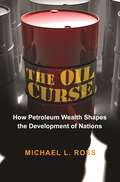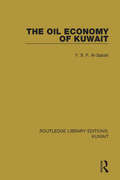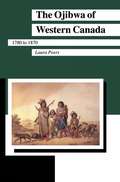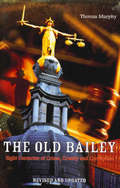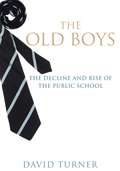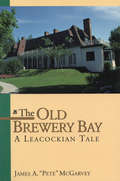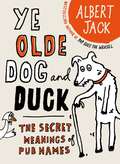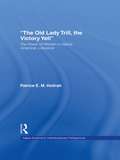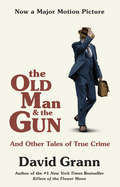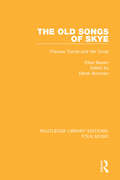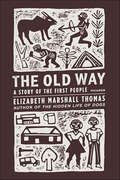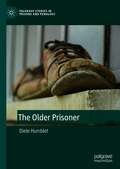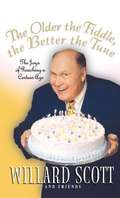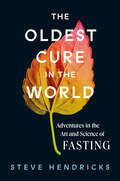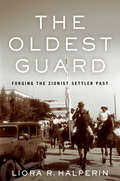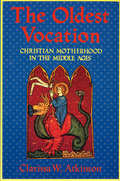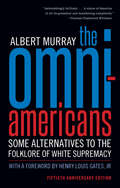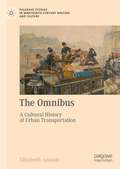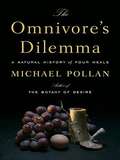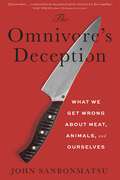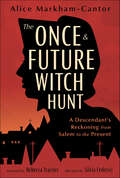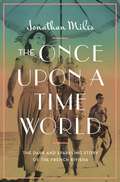- Table View
- List View
The Oil Curse: How Petroleum Wealth Shapes the Development of Nations
by Michael L. RossExplaining—and solving—the oil curse in the developing worldCountries that are rich in petroleum have less democracy, less economic stability, and more frequent civil wars than countries without oil. What explains this oil curse? And can it be fixed? In this groundbreaking analysis, Michael L. Ross looks at how developing nations are shaped by their mineral wealth—and how they can turn oil from a curse into a blessing.Ross traces the oil curse to the upheaval of the 1970s, when oil prices soared and governments across the developing world seized control of their countries' oil industries. Before nationalization, the oil-rich countries looked much like the rest of the world; today, they are 50 percent more likely to be ruled by autocrats—and twice as likely to descend into civil war—than countries without oil.The Oil Curse shows why oil wealth typically creates less economic growth than it should; why it produces jobs for men but not women; and why it creates more problems in poor states than in rich ones. It also warns that the global thirst for petroleum is causing companies to drill in increasingly poor nations, which could further spread the oil curse.This landmark book explains why good geology often leads to bad governance, and how this can be changed.
The Oil Economy of Kuwait (Routledge Library Editions: Kuwait #6)
by Y.S.F. Al-SabahThe economy of Kuwait is almost wholly dependent on oil. Such dependence on a depletable resource invariably stores up problems for the future, and in the case of Kuwait, these problems are aggravated by the unusually large proportion of skilled immigrant labour in the country. Dr Al-Sabah’s analysis of the economy of Kuwait, first published in 1980, puts forward suggestions that would remedy the problems of this dual dependence, and indicates the room for substantial improvement in the various sectors of the Kuwaiti economy.
The Ojibwa of Western Canada 1780-1870 (Manitoba Studies in Native History #8)
by Laura PeersAmong the most dynamic Aboriginal peoples in western Canada today are the Ojibwa, who have played an especially vital role in the development of an Aboriginal political voice at both levels of government. Yet, they are relative newcomers to the region, occupying the parkland and prairies only since the end of the 18th century. This work traces the origins of the western Ojibwa, their adaptations to the West, and the ways in which they have coped with the many challenges they faced in the first century of their history in that region, between 1780 and 1870.The western Ojibwa are descendants of Ojibwa who migrated from around the Great Lakes in the late 18th century. This was an era of dramatic change. Between 1780 and 1870, they survived waves of epidemic disease, the rise and decline of the fur trade, the depletion of game, the founding of non-Native settlement, the loss of tribal lands, and the government's assertion of political control over them. As a people who emerged, adapted, and survived in a climate of change, the western Ojibwa demonstrate both the effects of historic forces that acted upon Native peoples, and the spirit, determination, and adaptive strategies that the Native people have used to cope with those forces. This study examines the emergence of the western Ojibwa within this context, seeing both the cultural changes that they chose to make and the continuity within their culture as responses to historical pressures.The Ojibwa of Western Canada differs from earlier works by focussing closely on the details of western Ojibwa history in the crucial century of their emergence. It is based on documents to which pioneering scholars did not have access, including fur traders' and missionaries' journals, letters, and reminiscences. Ethnographic and archaeological data, and the evidence of material culture and photographic and art images, are also examined in this well-researched and clearly written history.
The Old Bailey: Eight Centuries of Crime, Cruelty and Corruption
by Theresa MurphyThis is the story of an arena of crime and degradation, of infamy and human suffering. It is the history of the Old Bailey, an institution as flawed as all man-made attempts at justice are doomed to be.In the beginning there was barbarity and injustice. The court was packed with a restless, muttering mob, eager for the verdicts of 'Guilty' so they could enjoy public executions, hurling abuse and missiles at those with the noose around their neck. Today we fool ourselves that we have evolved beyond barbarism, but are made uneasy by the continuing exposure of miscarriage of justice. If we use the Old Bailey as a yardstick, it is possible to argue that mankind has not made much progress through the centuries. In these pages, we tour the courts of long ago, meeting the Dracula-garbed court chaplains, drunken, brutal judges and cold-blooded hangmen. With wit and skill, Theresa Murphy brings to life a cast of hundreds, from the well-known to the less imfamous, who together make up the harrowing history of the Old Bailey.
The Old Boys
by David TurnerTo many in the United Kingdom, the British public school remains the disliked and mistrusted embodiment of privilege and elitism. They have educated many of the country's top bankers and politicians over the centuries right up to the present, including the present Prime Minister. David Turner's vibrant history of Great Britain's public schools, from the foundation of Winchester College in 1382 to the modern day, offers a fresh reappraisal of the controversial educational system. Turner argues that public schools are, in fact, good for the nation and are presently enjoying their true "Golden Age," countering the long-held belief that these institutions achieved their greatest glory during Great Britain's Victorian Era. Turner's engrossing and enlightening work is rife with colorful stories of schoolboy revolts, eccentric heads, shocking corruption, and financial collapse. His thoughtful appreciation of these learning establishments follows the progression of public schools from their sometimes brutal and inglorious pasts through their present incarnations as vital contributors to the economic, scientific, and political future of the country.
The Old Brewery Bay
by James A. McGarveyHere we have the personal account of the misadventures that preceded the opening to the public of the Leacock home in 1958. Forty years ago, in October 1954, a committee was formed, chaired by Pete McGarvey, to acquire and preserve Stephen Leacock’s summer home, known as The Old Brewery Bay. Four years later a golden key opened the front door of the home, allowing Leacock fans to pay homage to the humorist in a setting he had prized above every other. As the years have passed, appreciation of Leacock’s genius has grown and today the Leacock Museum is open year-round to visitors from all parts of the globe. The Old Brewery Bay is a Leacockian yarn full of ironies, the greatest one being that the salvation of Leacock’s home was accomplished not by a national campaign involving governments, philanthropists, McGill alumni, and foundations (all of whom were approached in a spirit of urgency and all of whom backed away), but by a gang of naive and stubborn Orillians, using old-fashioned political moxie. Leacock would have loved that - his Mariposans showing the big sophisticated world how to get things done.
The Old Dog and Duck: The Secret Meanings of Pub Names
by Albert JackThis is a book for everyone who has ever wondered why pubs should be called The Cross Keys, The Dew Drop Inn or The Hope and Anchor. You'll be glad to know that there are very good - strange and memorable - reasons behind them all.After much research about (and in) pubs, Albert Jack brings together the stories behind pub names to reveal how they offer fascinating and subversive insights on our history, customs, attitudes and jokes in just the same way that nursery rhymes do. The Royal Oak, for instance, commemorates the tree that hid Charles II from Cromwell's forces after his defeat at Worcester; The Bag of Nails is a corruption of the Bacchanals, the crazed followers of Bacchus, the god of wine and drunkenness; The Cat and the Fiddle a mangling of Catherine La Fidele and a guarded gesture of support for Henry VIII's first, Catholic, wife Catherine of Aragon; plus many, many more. Here too are even more facts about everything from ghosts to drinking songs to the rules of cribbage and shove hapenny, showing that, ultimately, the story of pub history is really the story of our own popular history
The Old Lady Trill, the Victory Yell: The Power of Women in Native American Literature (Native Americans: Interdisciplinary Perspectives)
by Patrice HollrahFirst Published in 2004. Routledge is an imprint of Taylor & Francis, an informa company.
The Old Log School
by Gavin Hamilton GreenGavin Hamilton Green was well-known to Goderich visitors as the "racy, entertaining and genial proprietor" of Ye Olde Curiosity Shoppe. His writings describe the colourful, sometimes wily ways of pioneer history in Colborne Township and Huron County. Green supplies a large repertoire of witty anecdotes, which together with several illustrations of old-timers and old places, give his book the true atmosphere of the times to which they relate. The reader is carried from chuckles to tears as events unfold in his witty saga in which he alternates from participant to observer. His "odd expressions and pawky whimsies" are an absolute delight.
The Old Man and the Gun: And Other Tales of True Crime
by David GrannNow a major motion picture starring Robert Redford and Sissy Spacek, The Old Man and the Gun is here joined by two other riveting true-crime tales."The Old Man and the Gun" is the incredible story of a bank robber and prison escape artist who modeled himself after figures like Pretty Boy Floyd and who, even in his seventies, refuses to retire. "True Crime" follows the twisting investigation of a Polish detective who suspects that a novelist planted clues in his fiction to an actual murder. And "The Chameleon" recounts how a French imposter assumes the identity of a missing boy from Texas and infiltrates the boy's family, only to soon wonder whether he is the one being conned. In this mesmerizing collection, David Grann shows why he has been called a "worthy heir to Truman Capote" and "simply the best narrative nonfiction writer working today," as he takes the reader on a journey through some of the most intriguing and gripping real-life tales from around the world.
The Old Social Classes And The Revolutionary Movements Of Iraq (The Macat Library)
by Dale J. StahlHow do you solve a problem like understanding Iraq? For Hanna Batatu, the solution to this conundrum lay in generating alternative possibilities that effectively side-stepped the conventional wisdom of the time. <P><P>Historians had long held that Iraq – like other artificial creations of ex-colonial European powers, who drew lines onto the world map that ignored longstanding tribal, ethnic and religious ties – was best understood by delving into its political and religious history. Batatu used the problem solving skills of asking productive questions and generating alternative possibilities to argue that Iraq’s history was better understood through the lens of a Marxist analysis focused on socio-economic history.The Old Social Classes concludes that the divisions present in Iraq – and exposed by the revolutionary movements of the 1950s – are those characterized by the struggle for control over property and the means of production. Additionally, Batatu sought to establish that the most important political movements of the time, notably the nationalist Ba'athists and the pan-Arab Free Officers Movement, had their origins in a homegrown communist ideology inspired by local conditions and local inequality. <P><P> By posing new questions – and by undertaking a vast amount of research in primary sources, a rarity in the history of this region – Batatu was able to produce a strong, new solution to a longstanding historiographical puzzle.
The Old Songs of Skye: Frances Tolmie and Her Circle (Routledge Library Editions: Folk Music #1)
by Ethel BassinOriginally published in 1977. Frances Tolmie (1840-1926) was one of the foremost Gaelic folklore and folksong experts. This account of her life and work places her unique contribution to human song against a full personal, historical and cultural background. The book includes a selection of the songs she heard and wrote down, together with the part they played in her life and that of her circle and the larger community. Moving in a variety of circles, Frances Tolmie experienced the warm domesticity of an enlightened Skye manse, the cultural bustle of upper middle-class Edinburgh ‘entrepreneurs’, the romantic serious-mindedness of the first Cambridge women students, the sensitive nature-loving community round Ruskin at Coniston, and spent her later sociable years back in Scotland. This book, with its historical introduction by Flora MacLeod and musical introduction by Frank Howes along with Ethel Bassin's own detailed introduction, reflects her profound study of the song and folklore of her people, and describes how she recorded a precious part of British traditional culture, catching it alive and sharing it as truly as possible.
The Old Stones of Kingston: Its Buildings before 1867
by Margaret AngusKingston is remarkable in that the visual evidence of its place in Canadian history and in Canadian architecture is still here: many of its older streets are lined with houses built of stone, and charming old limestone farm houses are found even in new subdivisions, surrounded now by modern, split-level dwellings. This book will inform and delight all those who take pleasure in the old buildings and in the social history of this country. Mrs Angus presents the stories of some of the architecturally and historically important limestone buildings, and of their owners, and thus tells the story of Kingston from the landing of the Empire Loyalists in 1784, through its brief period as capital of Canada (1841-43) up to Confederation. Full-page photographs illustrate the buildings; maps show the changing shape of the community, and help the reader to locate the buildings discussed in the text.
The Old Way: A Story of the First People
by Elizabeth Marshall ThomasOne of our most influential anthropologists reevaluates her long and illustrious career by returning to her roots—and the roots of life as we know itWhen Elizabeth Marshall Thomas first arrived in Africa to live among the Kalahari San, or bushmen, it was 1950, she was nineteen years old, and these last surviving hunter-gatherers were living as humans had lived for 15,000 centuries. Thomas wound up writing about their world in a seminal work, The Harmless People (1959). It has never gone out of print.Back then, this was uncharted territory and little was known about our human origins. Today, our beginnings are better understood. And after a lifetime of interest in the bushmen, Thomas has come to see that their lifestyle reveals great, hidden truths about human evolution.As she displayed in her bestseller, The Hidden Life of Dogs, Thomas has a rare gift for giving voice to the voices we don't usually listen to, and helps us see the path that we have taken in our human journey. In The Old Way, she shows how the skills and customs of the hunter-gatherer share much in common with the survival tactics of our animal predecessors. And since it is "knowledge, not objects, that endure" over time, Thomas vividly brings us to see how linked we are to our origins in the animal kingdom.The Old Way is a rare and remarkable achievement, sure to stir up controversy, and worthy of celebration.
The Older Prisoner (Palgrave Studies in Prisons and Penology)
by Diete HumbletThis book critically explores the world of older prisoners to provide a more nuanced understanding of imprisonment at old age. Through an ethnographical study of male and female older prisoners in two Belgian prison settings, one in which older prisoners are integrated and one in which they are segregated, it informs debates and seeks to recognise ageist discourse, attitudes, practices in prison. The Older Prisoner seeks to situate the older prisoner from both a penological and gerontological perspective, organised around the following broad themes: the construction of the older prisoner, the physical prison world, the social prison world, surviving prison and giving meaning. The book allows readers to navigate between contrasting perspectives and voices rather than reinforcing traditional narratives and prevailing discourses on the older prisoner. In doing so, it hopes to open up a broader dialogue on ageing and punishment. It also offers insights into the concept of meaning in life as an analytical tool to study prisoners.
The Older the Fiddle, the Better the Tune: The Joys of Reaching a Certain Age
by Willard ScottWhether you're turning 40, 60, or 85-there is so much to celebrate about getting older! "For me, one of the joys of being over 65 is that people have stopped trying to sell you life insurance."
The Oldest Cure in the World: Adventures in the Art and Science of Fasting
by Steve HendricksA journalist delves into the history, science, and practice of fasting, an ancient cure enjoying a dynamic resurgence. When should we eat, and when shouldn’t we? The answers to these simple questions are not what you might expect. As Steve Hendricks shows in The Oldest Cure in the World, stop eating long enough and you’ll set in motion cellular repairs that can slow aging and prevent and reverse diseases like diabetes and hypertension. Fasting has improved the lives of people with epilepsy, asthma, and arthritis, and has even protected patients from the worst of chemotherapy’s side effects. But for such an elegant and effective treatment, fasting has had a surprisingly long and fraught history. From the earliest days of humanity and the Greek fathers of medicine through Christianity’s “fasting saints” and a 19th-century doctor whose stupendous 40-day fast on a New York City stage inaugurated the modern era of therapeutic fasting, Hendricks takes readers on a rich and comprehensive tour. Threaded throughout are Hendricks’s own adventures in fasting, including a stay at a luxurious fasting clinic in Germany and in a more spartan one closer to home in Northern California. This is a playful, insightful, and persuasive exploration of our bodies and when we should—and should not—feed them.
The Oldest Guard: Forging the Zionist Settler Past (Stanford Studies in Jewish History and Culture)
by Liora R. HalperinThe Oldest Guard tells the story of Zionist settler memory in and around the private Jewish agricultural colonies (moshavot) established in late nineteenth-century Ottoman Palestine. Though they grew into the backbone of lucrative citrus and wine industries of mandate Palestine and Israel, absorbed tens of thousands of Jewish immigrants, and became known as the "first wave" (First Aliyah) of Zionist settlement, these communities have been regarded—and disregarded—in the history of Zionism as sites of conservatism, lack of ideology, and resistance to Labor Zionist politics. Treating the "First Aliyah" as a symbol created and deployed only in retrospect, Liora R. Halperin offers a richly textured portrait of commemorative practices between the 1920s and the 1960s. Drawing connections to memory practices in other settler societies, The Oldest Guard demonstrates how private agriculturalists and their advocates in the Zionist center and on the right celebrated and forged the "First Aliyah" past, revealing the centrality of settlement to Zionist collective memory and the politics of Zionist settler "firstness."
The Oldest Vocation: Christian Motherhood in the Medieval West
by Clarissa W. AtkinsonAccording to an old story, a woman concealed her sex and ruled as pope for a few years in the ninth century. Pope Joan was not betrayed by a lover or discovered by an enemy; her downfall came when she went into labor during a papal procession through the streets of Rome. From the myth of Joan to the experiences of saints, nuns, and ordinary women, The Oldest Vocation brings to life both the richness and the troubling contradictions of Christian motherhood in medieval Europe.After tracing the roots of medieval ideologies of motherhood in early Christianity, Clarissa W. Atkinson reconstructs the physiological assumptions underlying medieval notions about women's bodies and reproduction; inherited from Greek science and popularized through the practice of midwifery, these assumptions helped shape common beliefs about what mothers were. She then describes the development of "spiritual motherhood" both as a concept emerging out of monastic ideologies in the early Middle Ages and as a reality in the lives of certain remarkable women. Atkinson explores the theological dimensions of medieval motherhood by discussing the cult of the Virgin Mary in twelfth-century art, story, and religious expression. She also offers a fascinating new perspective on the women saints of the later Middle Ages, many of whom were mothers; their lives and cults forged new relationships between maternity and holiness. The Oldest Vocation concludes where most histories of motherhood begin—in early modern Europe, when the family was institutionalized as a center of religious and social organization.Anyone interested in the status of motherhood, or in women's history, the cultural history of the Middle Ages, or the history of religion will want to read this book.
The Omni-Americans: Some Alternatives to the Folklore of White Supremacy (Library Of America Albert Murray Edition Ser. #1)
by Albert MurrayRediscover the "most important book on black-white relationships" in America in a special 50th anniversary edition introduced by Henry Louis Gates, Jr."The United States is in actuality not a nation of black people and white people. It is a nation of multicolored people. . . . Any fool can see that the white people are not really white, and that black people are not black. They are all interrelated one way or another." These words, written by Albert Murray at the height of the Black Power movement, cut against the grain of their moment, and announced the arrival of a major new force in American letters. In his 1970 classic The Omni-Americans, Murray took aim at protest writers and social scientists who accentuated the "pathology" of race in American life. Against narratives of marginalization and victimhood, Murray argued that black art and culture, particularly jazz and blues, stand at the very headwaters of the American mainstream, and that much of what is best in American art embodies the "blues-hero tradition"--a heritage of grace, wit, and inspired improvisation in the face of adversity. Reviewing The Omni-Americans in 1970, Walker Percy called it "the most important book on black-white relationships . . . indeed on American culture . . . published in this generation." As Henry Louis Gates, Jr. makes clear in his introduction, Murray's singular poetic voice, impassioned argumentation, and pluralistic vision have only become more urgently needed today.
The Omnibus: A Cultural History of Urban Transportation (Palgrave Studies in Nineteenth-Century Writing and Culture)
by Elizabeth AmannThe introduction of omnibus services in the late 1820s revolutionised urban life in Paris, London and many other cities. As the first form of mass transportation—in principle, they were ‘for everyone’—they offered large swaths of the population new ways of seeing both the urban space and one another. This study examines how the omnibus gave rise to a vast body of cultural representations that probed the unique social experience of urban transit. These representations took many forms—from stories, plays and poems to songs, caricatures and paintings—and include works by many well-known artists and authors such as Picasso and Pissarro and Charles Dickens, Wilkie Collins and Guy de Maupassant. Analysing this corpus, the book explores how the omnibus and horse-drawn tram functioned in the cultural imagination of the nineteenth century and looks at the types of stories and values that were projected upon them. The study is comparative in approach and considers issues of gender, class and politics, as well as genre and narrative technique.
The Omnivore's Dilemma: A Natural History of Four Meals
by Michael PollanOne of the New York Times Book Review's Ten Best Books of the Year Winner of the James Beard Award Author of #1 New York Times Bestsellers In Defense of Food and Food Rules <P><P>What should we have for dinner? Ten years ago, Michael Pollan confronted us with this seemingly simple question and, with The Omnivore’s Dilemma, his brilliant and eye-opening exploration of our food choices, demonstrated that how we answer it today may determine not only our health but our survival as a species. <P>In the years since, Pollan’s revolutionary examination has changed the way Americans think about food. <P>Bringing wide attention to the little-known but vitally important dimensions of food and agriculture in America, Pollan launched a national conversation about what we eat and the profound consequences that even the simplest everyday food choices have on both ourselves and the natural world. <P>Ten years later, The Omnivore’s Dilemma continues to transform the way Americans think about the politics, perils, and pleasures of eating.
The Omnivore’s Deception: What We Get Wrong about Meat, Animals, and Ourselves
by John SanbonmatsuOffers the most powerful case yet for ending our exploitation of animals for foodMillions of Americans see themselves as "conflicted omnivores," worrying about the ethical and environmental implications of their choice to eat animals. Yet their attempts to justify their choices only obscure the truth of the matter: in John Sanbonmatsu’s view, killing and eating animals is unethical, regardless of whether they are "free range" or factory farmed. Shattering the conventional wisdom around the meat economy, he reframes the question of animal agriculture from one of "sustainability" to one of existential and moral purpose, presenting a powerful case for the total abolition of the animal economy. In a rejoinder to Michael Pollan and other critics who have told us that we can have our meat and our consciences, too, he shows why "humane meat" is always a contradiction in terms.The Omnivore’s Deception provides a deeply observed philosophical meditation on the nature of our relationship with animals. Peeling back the myriad layers of myth, falsehoods, and bad faith that keep us eating meat, the book offers a novel perspective on our troubled relations with animals in the food economy. The problem with raising and killing animals for food isn't just that it's "bad for the environment,” but the wrong way to live a human life. A tour de force of moral philosophy and cultural critique, The Omnivore's Deception will change the way we think about meat, animals, and human purpose.
The Once & Future Witch Hunt: A Descendant's Reckoning from Salem to the Present
by Alice Markham-CantorPast and present collide in this page-turning investigation into Salem's irrepressible question: how could this have happened?In 1692, Martha Allen Carrier was hanged in the Salem witch trials as the "Queen of Hell." Three hundred years later, her nine-times-great-granddaughter, Alice Markham-Cantor, set out to discover why Martha had died. As she chased her ancestor through the archives, graveyards, and haunted places of New England, grappling with what we owe the past, Alice discovered a shocking truth: witch hunts didn't end in Salem.Extensively researched and told through alternating fiction and non-fiction chapters, The Once & Future Witch Hunt does not treat Salem as a cautionary tale. It treats Salem as an instruction manual—not on how to perform witch hunts, but how to stop them.Foreword by Rebecca Traister, New York Times bestselling author.Afterword by Silvia Federici, author of Caliban and the Witch.
The Once Upon a Time World: The Dark and Sparkling Story of the French Riviera
by Jonathan MilesChronicling two-hundred years of glamour, intrigue, and hedonism, this rich and vivid history of the French Riviera features a vast cast of characters, from Pablo Picasso and Coco Chanel to Andre Matisse and James Baldwin.1835, Lord Brougham founded Cannes, introducing bathing and the manicured lawn to the wilds of the Mediterranean coast. Today, much of that shore has become a concrete mass from which escape is an exclusive dream. In the 185 years between, the stretch of seaboard from the red mountains of the Esterel to the Italian border hosted a cultural phenomenon well in excess of its tiny size. A mere handful of towns and resorts created by foreign visitors - notably English, Russian and American - attracted the talented, rich and famous as well as those who wanted to be. For nearly two centuries of creativity, luxury, excess, scandal, war and corruption, the dark and sparkling world of the Riviera was a temptation for everybody who was anybody. Often frivolous, it was also a potent cultural matrix that inspired the likes of Picasso, Matisse, Coco Chanel, Scott Fitzgerald, Cole Porter, James Baldwin, Catherine Mansfield, Sartre and Stravinsky. In Once Upon a Time World, Jonathan Miles presents the remarkable story of the small strip of French coast that lured the world to its shores. It is a wild and unforgettable tale that follows the Riviera's transformation from paradise and wilderness to a pollution imperiled concrete jungle.
